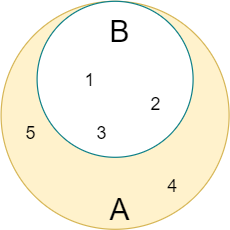Summary: in this tutorial, you’ll learn how to use the Python issuperset() method to check if a set is a superset of another.
Introduction to Python issuperset method #
Suppose that you have two sets: A and B. A is a superset of B if all elements of B are elements of A.
If A is a superset of B, then B is a subset of A. To check if a set is a subset of another, you use the issubset() method.
If set A and set B are not equal, set A is a proper superset of set B.
Logically, a set is a superset of itself.
The following illustrates that set A is the superset of the set B because the elements 1, 2, 3 in the set B are also in set A:

In Python, you use the set issuperset() method to check if a set is a superset of another set:
set_a.issuperset(set_b)Code language: Python (python)The issuperset() returns True if the set_a is a superset of the set_b. Otherwise, it returns False.
Python issuperset() method examples #
The following example uses the issuperset() to check if the numbers set is a superset of the scores set:
numbers = {1, 2, 3, 4, 5}
scores = {1, 2, 3}
result = numbers.issuperset(scores)
print(result)Code language: Python (python)Output:
TrueCode language: Python (python)Since all elements of the scores set are present in the numbers set, the numbers set is the superset of the scores set.
A set is also a superset of itself. For example:
numbers = {1, 2, 3, 4, 5}
result = numbers.issuperset(numbers)
print(result)Code language: Python (python)Output:
TrueCode language: Python (python)The scores set is not a subset of the numbers set therefore the following example returns False:
numbers = {1, 2, 3, 4, 5}
scores = {1, 2, 3}
result = scores.issuperset(numbers)
print(result)Code language: Python (python)Output:
FalseCode language: Python (python)Using superset operators #
The >= operator determines if a set is a superset of another set:
set_a >= set_bCode language: Python (python)The >= operator returns True if the set_a is a superset of the set_b. Otherwise, it returns False. For example:
numbers = {1, 2, 3, 4, 5}
scores = {1, 2, 3}
result = numbers >= scores
print(result) # True
result = numbers >= numbers
print(result) # TrueCode language: Python (python)Output:
True
TrueCode language: Python (python)To check if a set is a proper superset of another set, you use the > operator:
set_a > set_bCode language: Python (python)For example:
numbers = {1, 2, 3, 4, 5}
scores = {1, 2, 3}
result = numbers > scores
print(result) # True
result = numbers > numbers
print(result) # TrueCode language: Python (python)Output:
True
FalseCode language: Python (python)In this example, the set numbers is not a proper superset of itself, therefore, the > operator returns False.
Summary #
- The set A is a superset of a set B if all elements of set B are elements of set A.
- Use the Python
issuperset()method to check if a set is a superset of another. - Use the superset operator (
>=) or proper superset operator (>) to check if a set is a superset or a proper superset of another set.